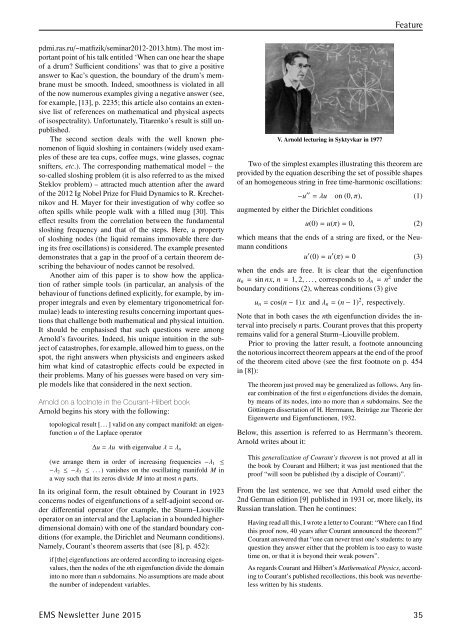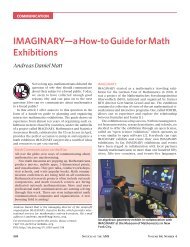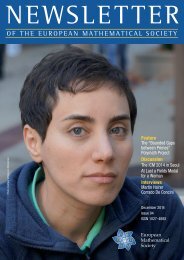2015-06-96
2015-06-96
2015-06-96
- No tags were found...
Create successful ePaper yourself
Turn your PDF publications into a flip-book with our unique Google optimized e-Paper software.
Featurepdmi.ras.ru/~matfizik/seminar2012-2013.htm). The most importantpoint of his talk entitled ‘When can one hear the shapeof a drum? Sufficient conditions’ was that to give a positiveanswer to Kac’s question, the boundary of the drum’s membranemust be smooth. Indeed, smoothness is violated in allof the now numerous examples giving a negative answer (see,for example, [13], p. 2235; this article also contains an extensivelist of references on mathematical and physical aspectsof isospectrality). Unfortunately, Titarenko’s result is still unpublished.The second section deals with the well known phenomenonof liquid sloshing in containers (widely used examplesof these are tea cups, coffee mugs, wine glasses, cognacsnifters, etc.). The corresponding mathematical model – theso-called sloshing problem (it is also referred to as the mixedSteklov problem) – attracted much attention after the awardof the 2012 Ig Nobel Prize for Fluid Dynamics to R. Krechetnikovand H. Mayer for their investigation of why coffee sooften spills while people walk with a filled mug [30]. Thiseffect results from the correlation between the fundamentalsloshing frequency and that of the steps. Here, a propertyof sloshing nodes (the liquid remains immovable there duringits free oscillations) is considered. The example presenteddemonstrates that a gap in the proof of a certain theorem describingthe behaviour of nodes cannot be resolved.Another aim of this paper is to show how the applicationof rather simple tools (in particular, an analysis of thebehaviour of functions defined explicitly, for example, by improperintegrals and even by elementary trigonometrical formulae)leads to interesting results concerning important questionsthat challenge both mathematical and physical intuition.It should be emphasised that such questions were amongArnold’s favourites. Indeed, his unique intuition in the subjectof catastrophes, for example, allowed him to guess, on thespot, the right answers when physicists and engineers askedhim what kind of catastrophic effects could be expected intheir problems. Many of his guesses were based on very simplemodels like that considered in the next section.Arnold on a footnote in the Courant–Hilbert bookArnold begins his story with the following:topological result [. . . ] valid on any compact manifold: an eigenfunctionu of the Laplace operator∆u = λu with eigenvalue λ = λ n(we arrange them in order of increasing frequencies −λ 1 ≤−λ 2 ≤−λ 3 ≤ ...) vanishes on the oscillating manifold M ina way such that its zeros divide M into at most n parts.In its original form, the result obtained by Courant in 1923concerns nodes of eigenfunctions of a self-adjoint second orderdifferential operator (for example, the Sturm–Liouvilleoperator on an interval and the Laplacian in a bounded higherdimensionaldomain) with one of the standard boundary conditions(for example, the Dirichlet and Neumann conditions).Namely, Courant’s theorem asserts that (see [8], p. 452):if [the] eigenfunctions are ordered according to increasing eigenvalues,then the nodes of the nth eigenfunction divide the domaininto no more than n subdomains. No assumptions are made aboutthe number of independent variables.V. Arnold lecturing in Syktyvkar in 1977Two of the simplest examples illustrating this theorem areprovided by the equation describing the set of possible shapesof an homogeneous string in free time-harmonic oscillations:−u ′′ = λu on (0,π), (1)augmented by either the Dirichlet conditionsu(0) = u(π) = 0, (2)which means that the ends of a string are fixed, or the Neumannconditionsu ′ (0) = u ′ (π) = 0 (3)when the ends are free. It is clear that the eigenfunctionu n = sin nx, n = 1, 2,..., corresponds to λ n = n 2 under theboundary conditions (2), whereas conditions (3) giveu n = cos(n − 1)x and λ n = (n − 1) 2 , respectively.Note that in both cases the nth eigenfunction divides the intervalinto precisely n parts. Courant proves that this propertyremains valid for a general Sturm–Liouville problem.Prior to proving the latter result, a footnote announcingthe notorious incorrect theorem appears at the end of the proofof the theorem cited above (see the first footnote on p. 454in [8]):The theorem just proved may be generalized as follows. Any linearcombination of the first n eigenfunctions divides the domain,by means of its nodes, into no more than n subdomains. See theGöttingen dissertation of H. Herrmann, Beiträge zur Theorie derEigenwerte und Eigenfunctionen, 1932.Below, this assertion is referred to as Herrmann’s theorem.Arnold writes about it:This generalization of Courant’s theorem is not proved at all inthe book by Courant and Hilbert; it was just mentioned that theproof “will soon be published (by a disciple of Courant)”.From the last sentence, we see that Arnold used either the2nd German edition [9] published in 1931 or, more likely, itsRussian translation. Then he continues:Having read all this, I wrote a letter to Courant: “Where can I findthis proof now, 40 years after Courant announced the theorem?”Courant answered that “one can never trust one’s students: to anyquestion they answer either that the problem is too easy to wastetime on, or that it is beyond their weak powers”.As regards Courant and Hilbert’s Mathematical Physics, accordingto Courant’s published recollections, this book was neverthelesswritten by his students.EMS Newsletter June <strong>2015</strong> 35






